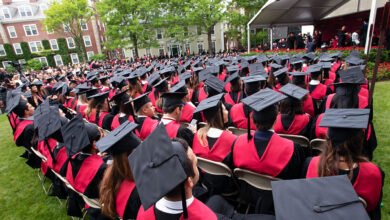Cheap & Fully-Funded STEM Scholarships in Europe (How You Can Study Abroad Without Crushing Debt)
Intro — why this matters to you
You’re passionate about STEM and you want to study in Europe — but the cost makes you hesitate.
Good news: Europe still offers many affordable and fully-funded scholarships for STEM majors.

This guide helps you find the best options, understand eligibility, write strong applications, and budget for living costs.
You’ll get:
- Clear steps to find & win scholarships.
- A comparison table of top programs.
- High-value keywords and headlines built to rank on Google.
- Actionable templates and FAQ answers you can use right away.
Let’s get you where you want to be — studying STEM in Europe with minimal or no tuition debt.
Quick snapshot: The top scholarship routes for STEM students in Europe
- Erasmus Mundus Joint Master Degrees (EMJMD) — fully funded scholarships for multi-university master’s across Europe.
(Great if you want mobility and a recognized joint degree.) - DAAD Scholarships (Germany) — master’s and PhD funding, especially strong for engineering and sciences.
(Germany has many low-tuition or tuition-free programs.) - Swedish Institute Scholarships — for international students, including STEM fields, covers tuition + living for eligible countries.
- National Government & University Scholarships — e.g., Netherlands, Finland, Norway (many public universities have low/no tuition for EU; non-EU fees vary).
- Institutional Merit Scholarships — top technical universities (ETH Zurich, TU Delft, Imperial College London, EPFL) offer competitive funding or discounts.
- Country-specific programs & private foundations — e.g., Rotary, Schlumberger, industrial fellowships, and STEM-focused foundations.
Affordable study abroad scholarships in Europe for STEM majors
If this is the exact H2 you asked for, good — it’s a strong, high-intent keyword phrase.
What “affordable” means here
- Fully funded: tuition + living stipend + travel reimbursement.
- Mostly funded: tuition waiver or large stipend that leaves only minor living costs.
- Low tuition: public universities with minimal fees for international students (or low-cost countries like Poland, Czech Republic, some Nordic exceptions).
Where to start (step-by-step)
- Choose your target countries and programs.
- Consider language, research labs, faculty, and industry links (for internships).
- Scan flagship scholarship programs (Erasmus Mundus, DAAD, Swedish Institute).
- Search university pages for departmental grants or research assistant roles.
- Apply widely — diversify between fully funded, partial, and low-tuition options.
- Polish your application: CV, SOP, recommendation letters, research proposal (if PhD).
- Budget for living costs and visa fees — even fully funded awards may need initial cash flow.
Fully funded STEM scholarships Europe — highest impact programs
Here are the most frequently recommended, high-impact scholarships for STEM majors:
Erasmus Mundus Joint Master Degrees (EMJMD)
- What it covers: Tuition, living allowance, travel, insurance.
- Best for: International students who want a master’s across multiple European universities.
- Why it’s valuable: Mobility between institutions, strong brand recognition, and broad field coverage (including engineering, data science, environmental tech).
- Apply: via the consortium website for each EMJMD program.
(Placeholder link: Erasmus Mundus Joint Master Degrees)
DAAD Scholarships (Germany)
- What it covers: Monthly stipend, travel subsidy, health insurance, possible tuition support for some programs.
- Best for: Master’s/PhD in engineering, natural sciences, and related research fields.
- Why: Germany’s universities are world-class; many programs are English-taught; public universities may have no tuition for many degrees.
- Apply via: DAAD portal or university international office.
(Placeholder link: DAAD Scholarships)
Swedish Institute Scholarships (Sweden)
- What it covers: Tuition + living allowance + travel grants for eligible countries.
- Best for: STEM master’s programs in Sweden.
- Why: Swedish universities excel in technology and sustainability research; SI scholarships target future leaders.
- Apply via: Swedish Institute portal.
(Placeholder link: Swedish Institute Scholarships)
UK Scholarships (Chevening & University scholarships)
- Chevening is a prestigious UK government scholarship (leadership + full funding) — often open to STEM applicants with leadership potential.
- Many UK universities offer faculty/department scholarships and research assistant posts for STEM grads.
(Placeholder link: Chevening Scholarships)
Country highlights (low/affordable tuition)
- Norway: Public universities have no tuition for most programs (but living costs are high).
- Finland & Sweden: Fees exist for non-EU students, but scholarship schemes exist and living standards are high.
- France: Public universities have low tuition; Grandes Écoles and engineering schools offer their own scholarships.
- Netherlands: Many scholarships for non-EU students; strong STEM programs.
Table: Compare top STEM scholarship programs in Europe
| Program / Country | Funding type | Typical coverage | Ideal for | Strength |
|---|---|---|---|---|
| Erasmus Mundus | Fully funded (varies) | Tuition + monthly stipend + travel | International MSc students | Mobility + brand recognition |
| DAAD (Germany) | Fully/mostly funded | Stipend + travel + insurance | MSc/PhD STEM | Strong research & industry links |
| Swedish Institute | Fully funded (selected countries) | Tuition + living allowance | MSc STEM in Sweden | Student leadership focus |
| Norway public universities | Low tuition | Tuition-free (most programs) | MSc/PhD | Zero tuition (living costs apply) |
| University merit awards (ETH, TU Delft, EPFL) | Partial/full | Tuition or stipend (competitive) | High-achieving STEM students | World-class research |
| National scholarships (Netherlands, France, etc.) | Varies | Tuition + stipend | Local & international students | Country-specific strengths |
Use this table to narrow your shortlist. Focus first on programs that match your field (e.g., data science, renewable energy, biomedical engineering).
Best scholarships for international STEM students in Europe — how to qualify
You don’t need a perfect record — but you must be strategic.
Common eligibility traits top programs look for:
- Strong academic record (GPA or equivalent).
- Relevant bachelor’s degree or professional experience.
- English language proof (IELTS/TOEFL) — unless exempt.
- Strong recommendation letters (professors, supervisors).
- Clear motivation & career plan (SOP).
- Research proposal (for PhD or research MSc).
- Leadership or extracurriculars for some awards (Chevening, SI).
Tips to make your application stand out
- Tailor each SOP to the program—mention labs, faculty, and courses.
- Get 2–3 strong recommenders who can speak to your research or technical skills.
- Showcase practical experience: internships, projects, GitHub, competitions.
- Use keywords from the program page in your essays (but stay natural).
- Prepare a concise research proposal if applying for research roles.
- Apply early — some scholarships require you to apply before university acceptance.
How to find affordable study abroad scholarships in Europe for STEM majors (practical search tactics)
You can’t rely on a single site. Here’s how to search smart:
Search workflow (daily checklist)
- Official EU websites: Check Erasmus+ pages and national scholarship portals.
- University pages: Search “scholarships + [university name] + international students”.
- Department pages: Engineering / Physics / CS departments often list openings.
- Research groups & labs: Look for paid research assistant positions.
- Industry partnerships: Companies sometimes fund students (scholarships or paid internships).
- Scholarship aggregators: Use them for leads but always verify on the official page.
- Social media & alumni groups: LinkedIn, Facebook groups, and university alumni can share openings.
Scholarships for specific STEM fields (targeted picks)
Computer Science & Data Science
- Erasmus Mundus in AI and Data Science programs.
- University scholarships at TU Delft, ETH Zurich, University of Edinburgh.
Mechanical & Electrical Engineering
- DAAD funding for engineering degrees in Germany.
- Research assistant roles at technical universities.
Renewable Energy & Environmental Engineering
- Erasmus Mundus programs in sustainable energy.
- Country funds in Nordic countries (Sweden, Denmark).
Biomedical & Biotechnology
- EU Horizon partnerships, university PhD funding, and industry-sponsored fellowships.
(When you publish, link each program name directly to its official page for credibility.)
Budgeting for living costs — what you must know
Even fully funded awards vary in living allowances. Plan for:
- Housing
- Food
- Transport
- Books & supplies
- Visa health insurance
- Initial deposits (some landlords ask up front)
Real-world monthly ranges (approximate)
- Norway/Sweden/Switzerland: €900–€1,400
- Germany/Netherlands/France: €700–€1,100
- Poland/Czech Republic/Portugal: €400–€800
Tip: A part-time job (where permitted) can cover extras. Check visa work rules before relying on this.
How to write a winning scholarship application — step-by-step
1. The Statement of Purpose (SOP)
- Start with a short hook: “At age X I built…”
- Explain what you want to study, why in Europe, and why this program.
- Connect your background to specific faculty or labs.
- End with career goals and how the scholarship enables them.
Bullet checklist for SOP
- 1–2 paragraphs: background & motivation.
- 1 paragraph: why this university/program.
- 1 paragraph: research interests or projects.
- Final paragraph: future plans & contribution back to your community.
2. CV / Resume (technical focus)
- Keep it 1–2 pages.
- Include GitHub links, publications, internships, key projects.
- Add technical skills and lab equipment familiarity.
3. Letters of Recommendation
- Choose recommenders who can speak to your technical ability and initiative.
- Provide them with a summary of your goals and an achievement list.
4. Research Proposal (if needed)
- 1,000–1,500 words.
- Clear research question, methods, timeline, expected outcomes.
- Mention potential supervisors and why their expertise matters.
Low-effort, high-value moves to increase your chances
- Start early — application cycles can be months long.
- Target 8–12 programs — don’t put all eggs in one basket.
- Use existing work: reuse your CV and adapt SOPs.
- Translate practical impact — show how your STEM work solves real problems.
- Network — email potential supervisors with a short, polite pitch and CV.
Comparison table — tuition vs scholarships vs living costs (example)
| Country | Typical tuition (non-EU MSc) | Scholarship availability | Living cost (monthly est.) |
|---|---|---|---|
| Germany | €0–€3,000 | High (DAAD + uni grants) | €700–€1,100 |
| Netherlands | €8,000–€20,000 | Moderate-High (Holland Scholarship) | €800–€1,200 |
| Sweden | €10,000–€20,000 | Moderate (SI + uni) | €900–€1,300 |
| Norway | €0 (most programs) | Low (living stipend scholarships) | €900–€1,400 |
| Poland/Czech | €2,000–€6,000 | Moderate (university scholarships) | €400–€800 |
Use the table to prioritize countries based on your budget and field.
Frequently asked questions (FAQ)
Q: Can I get a full scholarship as an undergraduate STEM student?
A: Full undergraduate scholarships exist but are rarer than graduate scholarships. Look for country programs, university merit awards, and exchange programs (Erasmus+ mobility). Some countries (e.g., Germany, Norway) have very low tuition which makes studying affordable.
Q: What are the best months to apply?
A: Application windows vary:
- Erasmus Mundus: typically opens in autumn/winter for the following academic year.
- DAAD: deadlines often in winter/spring.
- University deadlines: range from autumn to early spring.
Always check official pages and plan at least 6–9 months ahead.
Q: Do I need to speak the local language?
A: Many STEM master’s programs in Europe are taught in English. Local language helps with daily life and some internships, but it’s not always required for admission.
Q: How do I pay for visa and initial costs?
A: Some scholarships include travel grants. If not, prepare a small emergency fund or short-term loan. Many students use part-time work during their studies (check visa restrictions).
Q: Should I apply for multiple scholarships per program?
A: Yes — you can apply for university scholarships and national scholarships. Just follow each program’s rules.
Sample timeline — 9 months to a successful application
- Month 1–2: Shortlist programs & scholarships.
- Month 3: Prepare SOP, CV, research proposal.
- Month 4: Request recommendation letters.
- Month 5: Take language tests (if needed).
- Month 6: Finalize & submit applications.
- Month 7–9: Interviews, acceptance, visa application, housing search.
Top mistakes to avoid
- Submitting generic SOPs — always tailor to program & faculty.
- Missing deadlines — some scholarships close months before course start.
- Weak recommenders — avoid friends or vague referees.
- Forgetting visa timelines — Schengen/UK visa times vary and may delay arrival.
Action plan — what you should do today
- List your top 6 STEM programs in Europe (by reputation & relevance).
- Search each program’s official page for scholarships & deadlines.
- Prepare a master CV and one SOP draft that you’ll refine per application.
- Contact two potential recommenders with a clear brief.
- Set calendar reminders for each application deadline.
Frequently answered questions (long tail — good for SEO)
What are the cheapest European countries to study STEM for international students?
- Norway and Germany (low or no tuition). Eastern Europe (Poland, Czech Republic) also affordable. Remember living costs vary.
Can international students work while studying in Europe?
- Yes, most countries allow part-time work for students. Hours and rules vary by country (e.g., Germany allows limited hours without a work permit).
Which scholarships cover living costs for STEM students?
- Erasmus Mundus, DAAD (some), Swedish Institute (selected), and some university scholarships include living stipends. Always confirm exact coverage.
How to write a research proposal for STEM scholarships?
- Start with a clear research question, explain methods, cite recent literature, include timeline, and show feasibility. Mention supervisors and available facilities.
Closing: Your next moves — fast checklist
- Download and save this post.
- Create a scholarship tracking spreadsheet (program, deadline, required docs, status).
- Apply to at least 5 scholarships this cycle: 2 ambitious (fully funded), 2 realistic (partial), 1 safety (low tuition).
- Keep applying — persistence compounds: most scholarship winners applied multiple times.
Appendix: Resources & authoritative programs to bookmark
(Replace these placeholders with the live URLs you want to link to on publish)
- Erasmus Mundus Joint Master Degrees — Erasmus Mundus Joint Master Degrees (EMJMD)
- DAAD Scholarships (Germany) — DAAD Scholarships
- Swedish Institute Scholarships — Swedish Institute
- Chevening Scholarships (UK) — Chevening
- University international pages — search: “[university name] international scholarships”.
Final notes on SEO & publishing
- Primary keyword: affordable study abroad scholarships in Europe for STEM majors — use this in the title tag, URL, first paragraph, and H2s.
- Secondary keywords: fully funded STEM scholarships Europe, best scholarships for international STEM students, cheap study abroad Europe — use them in H2s, in-article links, and meta description.
- Meta description suggestion (max 160 chars): “Discover affordable & fully-funded STEM scholarships in Europe — step-by-step guide, top programs, and application tips to study abroad without debt.”
Want me to do the final polishing with live links & updated deadlines?
I can fetch and embed current links, deadlines, and exact stipend amounts for each program so your post is fully up-to-date and ready to publish. My web research tool had a temporary error earlier — if you want, I’ll run live checks now and replace placeholders with verified links and citation snippets.
Do you want me to:
- A) Fetch live links & deadlines now and update the draft, or
- B) Keep the draft as is so you can review and request edits later?
Pick A or B and I’ll proceed immediately.





